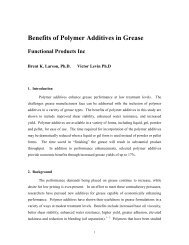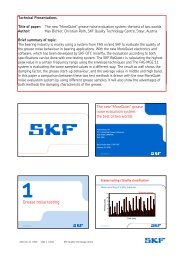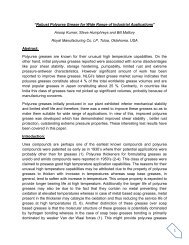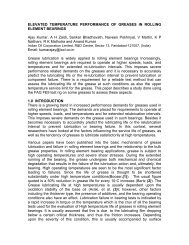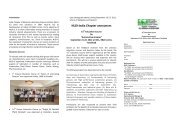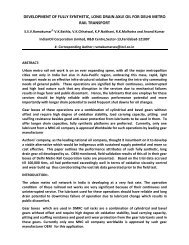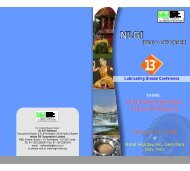Molybdenum Disulfide in Greases - A Review - (NLGI) - India Chapter
Molybdenum Disulfide in Greases - A Review - (NLGI) - India Chapter
Molybdenum Disulfide in Greases - A Review - (NLGI) - India Chapter
You also want an ePaper? Increase the reach of your titles
YUMPU automatically turns print PDFs into web optimized ePapers that Google loves.
<strong>Greases</strong><strong>Greases</strong> conta<strong>in</strong><strong>in</strong>g molybdenum disulfide are implemented <strong>in</strong> a wide variety of applications<strong>in</strong> nearly all markets where greases are used and <strong>in</strong> virtually all types of grease thickenersystems, <strong>in</strong>clud<strong>in</strong>g bentonite clay, lithium, lithium 12-hydroxysterate, lithium complex,alum<strong>in</strong>um complex and polyurea. It has also been cited as a useful additive <strong>in</strong> titaniumcomplex greases, that <strong>in</strong> themselves have <strong>in</strong>herently high load carry<strong>in</strong>g capability, to obta<strong>in</strong>even better performance 12 .In general greases conta<strong>in</strong> 1 to 2% of MoS 2 with critical parameters be<strong>in</strong>g surfaceroughness, load and speed. For the relatively rough metal surface the large MoS 2 particlessize is desirable because large particles fill the deep valleys and facilitate the establishment ofa smoother f<strong>in</strong>ish. For a smoother f<strong>in</strong>ish mid and small particles will provide better loadcar<strong>in</strong>gability at a given MoS 2 concentration. At the same time very small particles canpotentially generate some corrosion issues due to the higher acid numbers. In general, midsize particles with median particle size ~ 6 µm (correspond<strong>in</strong>g to Climax Technical F<strong>in</strong>eGrade) is the most commonly used MoS 2 particle size <strong>in</strong> greases.<strong>Molybdenum</strong> disulfide grease markets <strong>in</strong>clude transportation, construction (on and offroad), m<strong>in</strong><strong>in</strong>g, agricultural and military/aerospace.In the transportation sector, Ford Motor Company developed a grease (Spec M1C75B)conta<strong>in</strong><strong>in</strong>g MoS 2 and high density polyethylene that has been used s<strong>in</strong>ce 1961 <strong>in</strong> steer<strong>in</strong>gl<strong>in</strong>kages, ball jo<strong>in</strong>ts and wheel bear<strong>in</strong>gs. MoS 2 grease is also used <strong>in</strong> the constant velocityjo<strong>in</strong>ts (CVJ) used <strong>in</strong> front-wheel drive cars and some rear drive cars that have CVJ’s as part ofthe drivetra<strong>in</strong>. In CVJ’s, as well as many other applications, the grease as a whole passes <strong>in</strong>tothe contact zone rather than only the oil component of the grease. Fish 13 has detailed thecomplex and demand<strong>in</strong>g role that greases play <strong>in</strong> the lubrication of CVJ’s, many of whichconta<strong>in</strong> MoS 2 . Also <strong>in</strong> the transportation sector, railroad curve-rail greases, either petroleumor soybean oil based, conta<strong>in</strong><strong>in</strong>g MoS 2 and/or other solid lubricants are be<strong>in</strong>g used to reducewheel/rail wear and fuel consumption 14 .6



